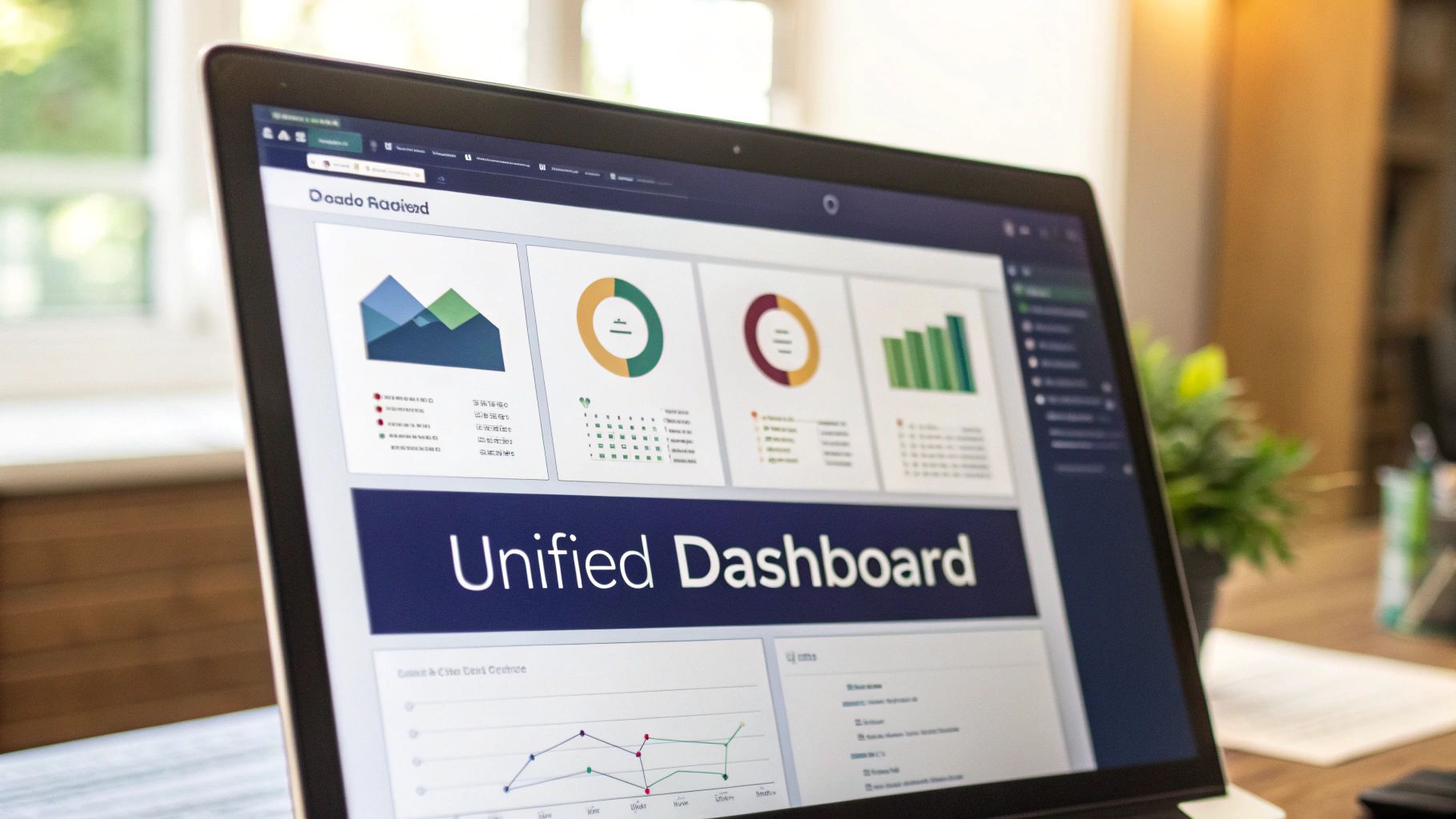
In the competitive landscape of nonprofit, government, and philanthropic funding, securing a grant is only the first step. The real challenge lies in managing it effectively to deliver on promises, ensure compliance, and maximize community impact. Outdated, fragmented processes often lead to missed deadlines, budget overruns, and strained funder relationships, ultimately undermining your organization's mission and credibility. This guide moves beyond generic advice to provide a strategic framework built on seven essential grant management best practices.
Adopting these proven strategies will not only streamline your administrative workload but also build a foundation of trust, transparency, and sustainable success. Whether you're a small nonprofit or a large government agency, these actionable insights will help you transform grant administration from a necessary burden into a strategic advantage. For ongoing insights and discussions on modern grant management techniques, exploring resources like Fundpilot's grant management blog can be highly beneficial.
This article details a modern, actionable approach, ensuring every dollar creates its intended change. We will cover critical areas including pre-award planning, centralized systems, robust financial tracking, compliance frameworks, risk management, stakeholder communication, and data-driven evaluation. Let's dive into the practices that will unlock your funding potential.
1. Pre-Award Planning and Preparation
The foundation of successful grant management is built long before any funds are awarded. This proactive phase, known as pre-award planning, involves a meticulous and strategic approach to preparing for a grant application. It moves beyond simple proposal writing to encompass comprehensive research, internal capacity assessment, and strategic alignment with potential funders. This critical first step sets the stage for the entire grant lifecycle and is one of the most vital grant management best practices for ensuring project success and minimizing post-award complications.

Effective pre-award preparation involves creating a detailed roadmap for your proposed project. This includes developing realistic budgets that account for all direct and indirect costs, establishing clear, measurable objectives, and building a comprehensive project timeline with key milestones. By front-loading this strategic work, organizations can submit more competitive, compelling, and compliant applications that funders are more likely to support.
How It Works in Practice
Leading grantmaking bodies and successful grantees exemplify the power of thorough preparation. The Gates Foundation, for instance, employs a rigorous pre-award process that heavily vets an organization's capacity and project design, contributing to a high project success rate. Similarly, the National Institutes of Health (NIH) has refined its application processes to be more structured, which helps reduce the administrative burden on both applicants and reviewers.
The Ford Foundation often integrates capacity-building requirements into its pre-award phase, ensuring grantees have the necessary operational strength to achieve their proposed outcomes. This focus on foundational readiness, popularized by organizations like the Council on Foundations and the Grant Professionals Association, transforms grant seeking from a reactive task into a strategic, mission-driven activity.
Actionable Tips for Implementation
To integrate this best practice into your grant management workflow, consider the following strategies:
- Start Early: Begin your planning process 6 to 12 months before application deadlines. This provides ample time for research, relationship-building, and proposal development.
- Develop Standardized Templates: Create internal templates for common application components like budget narratives, organizational history, and staff biographies to streamline the process.
- Conduct a Pilot Study: For innovative projects, running a smaller-scale pilot or proof-of-concept can generate valuable data and demonstrate feasibility to funders.
- Build Contingency Plans: Identify potential risks and develop contingency plans for various scenarios, such as budget shortfalls or timeline delays. This demonstrates foresight and robust planning.
2. Centralized Grant Management System
Managing multiple grants simultaneously using spreadsheets, emails, and disconnected documents creates administrative chaos and elevates compliance risks. A centralized grant management system consolidates all grant-related activities, documents, communications, and reporting into a single, accessible platform. Adopting this unified approach is a cornerstone grant management best practice that streamlines workflows, improves team collaboration, and provides real-time visibility into the performance of your entire grant portfolio.

This digital infrastructure moves organizations from fragmented, reactive administration to a proactive, data-driven strategy. By centralizing information, teams can easily track deadlines, manage budgets, monitor progress against milestones, and generate comprehensive reports for funders with just a few clicks. This not only boosts efficiency but also enhances transparency and accountability, strengthening relationships with grantors.
How It Works in Practice
The impact of centralization is evident across the nonprofit and academic sectors. United Way famously implemented Salesforce Nonprofit Cloud, increasing its operational efficiency by an estimated 40% by automating workflows and unifying data. Similarly, many community foundations have adopted the Blackbaud Grantmaking suite, with some reporting a reduction in grant processing time by as much as 50%.
Major research universities like Stanford and MIT, which manage grant portfolios exceeding a billion dollars, rely on sophisticated, often custom-built, systems to handle the immense complexity of federal and private funding requirements. These systems, pioneered by providers like Foundant Technologies and Fluxx Labs, demonstrate that a centralized platform is essential for scaling grant operations effectively and maintaining strict compliance.
Actionable Tips for Implementation
To successfully implement a centralized system, follow these strategic steps:
- Conduct a Thorough Needs Assessment: Before selecting a system, map your current grant lifecycle workflows, identify bottlenecks, and define your specific requirements.
- Involve End-Users Early: Engage program managers, finance staff, and grant writers in the selection and implementation process to ensure the chosen system meets their practical needs and encourages adoption.
- Plan for Data Migration: Develop a clear plan for migrating historical grant data from old systems (like spreadsheets) to the new platform. This is often the most challenging step.
- Establish Clear Governance: Create and enforce policies for data entry, user access levels, and reporting standards to maintain data integrity and security.
- Provide Comprehensive Training: Offer initial and ongoing training sessions to ensure all users are proficient and comfortable with the new system.
3. Robust Financial Tracking and Budget Management
Diligent financial oversight is the backbone of accountable grant management. This practice involves a comprehensive, real-time approach to monitoring, tracking, and managing grant funds throughout the entire project lifecycle. It goes beyond simple bookkeeping to encompass the establishment of clear budget categories, regular financial reviews, meticulous expense documentation, and strict adherence to funder requirements. Adopting robust financial controls is a critical grant management best practice that safeguards against non-compliance, prevents misuse of funds, and builds trust with funders.

Effective financial management ensures that every dollar is spent as intended, documented correctly, and aligned with the grant agreement. This level of detail protects the organization from costly audit findings and disallowed costs, which can jeopardize future funding opportunities. By implementing a strong financial framework, organizations can confidently demonstrate fiscal responsibility, leading to stronger donor relationships and a higher likelihood of grant renewal.
How It Works in Practice
Leading organizations demonstrate the tangible benefits of meticulous financial stewardship. For instance, Johns Hopkins University reportedly reduced its audit findings by 75% after implementing a more rigorous financial tracking and training system for its grant administrators. The American Red Cross deployed a sophisticated financial system that helped prevent an estimated $2 million in disallowed costs by flagging potentially non-compliant expenses before they were finalized.
Similarly, Mercy Corps’ transparent financial tracking systems have enhanced donor confidence, contributing to improved renewal rates on key programs. These practices, championed by bodies like the National Association of College and University Business Officers (NACUBO) and the Grant Professionals Association, transform financial management from a reactive, compliance-driven task into a proactive strategy for organizational sustainability and programmatic success.
Actionable Tips for Implementation
To embed this best practice into your organization's financial operations, focus on these strategies:
- Establish Clear Budget Categories: Structure your internal budget to mirror the funder's required format. This simplifies reporting and ensures direct alignment with the grant agreement.
- Implement Monthly Financial Reviews: Conduct monthly budget-versus-actual variance analyses with program staff to identify and address potential overspending or underspending early.
- Train All Staff on Cost Principles: Ensure every team member involved in spending grant funds understands the difference between allowable and unallowable costs according to funder rules.
- Maintain Detailed Documentation: Keep meticulous records, including invoices, receipts, and timesheets, for every expenditure. This documentation is essential for audits and financial reports.
- Use Automated Tools: Leverage grant management or accounting software to automate expense categorization, track spending against budget lines, and generate real-time financial reports.
4. Systematic Compliance and Reporting Framework
Once a grant is awarded, the focus shifts to meticulous execution and accountability. A systematic compliance and reporting framework is the operational backbone that ensures all grant requirements, regulations, and reporting obligations are met consistently and on time. This structured approach involves proactive compliance monitoring, standardized reporting processes, and diligent deadline management. Establishing this framework is one of the most critical grant management best practices for maintaining funder trust, ensuring financial integrity, and avoiding costly penalties.

This best practice moves beyond a simple checklist to create an integrated system where compliance is embedded in daily operations. It requires a deep understanding of each funder’s specific rules, from financial reporting formats to programmatic progress updates. To ensure timely and accurate submissions, mastering reporting automation can significantly enhance efficiency, reduce human error, and free up staff to focus on strategic program delivery rather than administrative burdens.
How It Works in Practice
Government agencies and large non-profits provide powerful models for this practice. The U.S. Office of Management and Budget (OMB) sets government-wide standards with its Uniform Guidance, which a robust compliance framework helps organizations follow. Similarly, the National Science Foundation (NSF) and the Department of Health and Human Services (HHS) have stringent reporting requirements that successful grantees manage through highly organized systems.
For instance, the University of California system successfully manages billions in annual grant funding through a sophisticated, decentralized compliance program tailored to diverse funder rules. Organizations like Habitat for Humanity have implemented standardized reporting templates across their affiliates, which has led to increased funder satisfaction and streamlined renewal processes. You can learn more about how to structure these systems by exploring real-world case studies on compliance for nonprofit organizations.
Actionable Tips for Implementation
To build a robust compliance and reporting framework, integrate these strategies into your workflow:
- Create Compliance Calendars: Develop a master calendar that consolidates all programmatic and financial reporting deadlines, audit dates, and key compliance activities for every grant.
- Use Standardized Templates: Design uniform templates for common report types, such as financial expenditure reports and quarterly progress updates, to ensure consistency and save time.
- Establish Internal Audits: Schedule regular internal reviews or spot-checks of grant expenditures and documentation to identify and correct potential compliance issues before they become problems.
- Maintain Comprehensive Documentation: Implement a centralized, accessible system for storing all grant-related documents, including the original proposal, award letter, correspondence, and submitted reports.
5. Comprehensive Risk Management and Contingency Planning
A proactive approach to risk is a hallmark of elite grant management. This involves more than just reacting to problems; it's about systematically identifying, assessing, and mitigating potential risks that could derail a project. By developing robust contingency plans and backup strategies, organizations can maintain flexibility and adapt to unexpected challenges. This strategic foresight is one of the most crucial grant management best practices for protecting project outcomes and ensuring grant funds are used effectively.
Effective risk management creates a framework for resilience. It requires organizations to anticipate potential issues, such as funding delays, staffing changes, or external disruptions, and develop clear action plans for each scenario. This structured process not only safeguards the project's objectives but also demonstrates a high level of accountability and operational maturity to funders, building trust and confidence in the grantee's ability to deliver.
How It Works in Practice
High-stakes operations provide powerful examples of risk management in action. Doctors Without Borders relies on sophisticated risk analysis to operate safely in conflict zones, allowing them to deliver critical medical care where it's needed most. Similarly, NASA’s legendary risk management protocols are credited with its 95% mission success rate, proving that even highly complex projects can be managed effectively with proper planning.
This practice has been systemized and popularized by organizations like the Project Management Institute (PMI) and the Risk Management Society, which provide frameworks for identifying and mitigating risks across various sectors. The World Wildlife Fund demonstrated the value of this approach during the COVID-19 pandemic by activating contingency plans that allowed vital conservation projects to continue despite global shutdowns, a powerful case study in nonprofit resilience. You can explore a deeper dive into nonprofit risk management strategies here.
Actionable Tips for Implementation
To build a robust risk management framework into your grant lifecycle, focus on these strategies:
- Conduct Regular Risk Assessments: Perform a thorough risk assessment during the planning phase and revisit it quarterly or at key project milestones to identify new or evolving threats.
- Maintain a Contingency Fund: Allocate 10-15% of the total project budget as a contingency line item to address unforeseen costs without jeopardizing core activities.
- Involve All Stakeholders: Engage project staff, partners, and even community members in the risk identification process to gain diverse perspectives and uncover potential blind spots.
- Document Everything: Maintain a risk register that documents all identified risks, their potential impact, mitigation strategies, and the final decisions made. This creates an audit trail and a learning resource for future projects.
6. Stakeholder Engagement and Communication Strategy
Effective grant management extends far beyond internal project teams and funder check-ins. It requires a structured approach to identifying, engaging, and maintaining positive relationships with every individual and group invested in the project's outcome. This includes funders, community beneficiaries, implementation partners, internal staff, and even policymakers. A robust stakeholder communication strategy is one of the most critical grant management best practices for building trust, ensuring buy-in, and navigating the complexities of project implementation.
A proactive engagement strategy ensures that expectations are managed, information flows freely, and collaborative decision-making is the norm. By treating stakeholders as active partners rather than passive recipients, organizations can foster a supportive ecosystem that enhances project sustainability and impact. This transforms communication from a simple reporting task into a strategic tool for risk mitigation and opportunity creation.
How It Works in Practice
Leading organizations demonstrate that systematic stakeholder engagement is directly linked to achieving ambitious goals. The Grameen Foundation, for instance, has successfully reached over 20 million beneficiaries by deeply embedding community feedback loops into its program design and delivery. Similarly, Teach for America maintains a remarkable 90% partner school retention rate, largely due to its structured strategy for engaging with principals, teachers, and district administrators.
The Environmental Defense Fund exemplifies this practice in the policy arena, using a collaborative, multi-stakeholder approach to achieve significant bipartisan environmental policy wins. This model, championed by institutions like the International Association of Public Participation and the Harvard Kennedy School, proves that bringing diverse voices to the table is not just good ethics, it is a prerequisite for lasting success.
Actionable Tips for Implementation
To integrate this best practice into your grant management workflow, consider the following strategies:
- Create a Stakeholder Map: Begin by identifying all stakeholders and mapping them on a grid based on their level of interest and influence. This helps prioritize communication efforts.
- Establish a Communication Schedule: Develop a clear plan outlining who needs what information, how they will receive it, and how often. This prevents both information gaps and communication overload.
- Use Diverse Communication Channels: Tailor your methods to your audience. A funder may prefer a formal quarterly report, while community members might engage better through a social media group or town hall meeting.
- Systematize Feedback Collection: Implement formal mechanisms like surveys, focus groups, and suggestion boxes to gather input, and more importantly, create a process for responding to and acting on that feedback.
- Document Key Interactions: Keep a clear record of significant conversations, decisions, and agreements with stakeholders to ensure accountability and maintain institutional memory. For a deeper look at creating a structured plan, this community engagement case study offers valuable insights.
7. Data-Driven Performance Monitoring and Evaluation
Effective grant management extends beyond financial compliance; it requires a systematic approach to measuring real-world impact. Data-driven performance monitoring and evaluation involves collecting, analyzing, and using data to track project progress, assess outcomes, and make informed decisions. By establishing clear metrics and regularly reviewing performance, organizations can demonstrate accountability, optimize their strategies, and prove the value of their work. This commitment to evidence-based practice is a cornerstone of modern grant management best practices.
This approach transforms evaluation from a final, retrospective report into an ongoing, dynamic process. It allows program managers to identify what is working and what isn't in near real-time, enabling course corrections that enhance effectiveness and maximize a grant's impact. For funders, this provides clear, quantifiable evidence of their investment's return, building trust and justifying continued support for successful initiatives.
How It Works in Practice
The power of rigorous evaluation is exemplified by leading philanthropic and research organizations. The Robin Hood Foundation's meticulous, data-centric approach has been shown to increase the cost-effectiveness of its programs by as much as 300%. Similarly, the Grameen Foundation has leveraged data-driven insights to improve its program outcomes by an estimated 40%, refining its microfinance and technology initiatives based on performance metrics.
This movement toward evidence-based programming was significantly advanced by organizations like the Abdul Latif Jameel Poverty Action Lab (J-PAL). By championing the use of randomized controlled trials (RCTs) in social policy, J-PAL has provided concrete evidence that influences global development policy, showing how specific interventions directly lead to positive outcomes. Consultants like FSG and the Center for Effective Philanthropy have further embedded these principles across the nonprofit sector.
Actionable Tips for Implementation
To integrate this best practice into your grant management workflow, consider the following strategies:
- Establish Baseline Data: Before project launch, collect baseline data to create a clear starting point against which you can measure progress and ultimate impact.
- Use Mixed-Method Approaches: Combine quantitative data (e.g., number of beneficiaries served, test scores) with qualitative data (e.g., interviews, success stories) for a holistic view of performance.
- Budget for Evaluation: Allocate 10-15% of your total project budget specifically for monitoring and evaluation activities, ensuring you have the resources for robust data collection and analysis.
- Create User-Friendly Dashboards: Develop and maintain simple visual dashboards to communicate key performance indicators (KPIs) to stakeholders, including your board, staff, and funders. This makes complex data accessible and actionable.
7 Key Practices Comparison Guide
From Best Practices to Best-in-Class Performance
Navigating the grant lifecycle, from initial opportunity to final closeout, is a complex journey filled with high stakes and significant administrative demands. The seven grant management best practices detailed in this article are not merely suggestions; they are the foundational pillars of a successful, sustainable, and impactful grant-funded program. By moving beyond ad-hoc processes and embracing a structured, strategic approach, your organization can transform its grant management from a necessary administrative function into a powerful engine for mission fulfillment.
The core theme connecting these practices, from pre-award planning to data-driven evaluation, is integration. Siloed efforts in financial tracking, compliance monitoring, and stakeholder communication create inefficiencies and increase risk. True mastery lies in creating a unified ecosystem where each practice informs and strengthens the others. This holistic view ensures that every action taken is deliberate, transparent, and aligned with your program's ultimate goals.
Elevating Your Grant Management Strategy
Implementing these principles requires a commitment to continuous improvement and a strategic investment in the right tools. The transition from theory to practice can seem daunting, but the benefits are substantial and far-reaching.
- Build Stronger Funder Relationships: Demonstrating robust financial controls, proactive risk management, and transparent reporting builds immense trust with grantors, paving the way for future funding opportunities.
- Maximize Program Impact: When your team spends less time on administrative burdens like chasing down paperwork or manually compiling reports, they can dedicate more energy to program delivery and achieving meaningful outcomes.
- Enhance Organizational Resilience: A systematic framework for compliance and risk management protects your organization from potential setbacks, ensuring long-term stability and the ability to navigate unforeseen challenges effectively.
The path to best-in-class performance begins with a single step. Start by assessing your current processes against the best practices outlined here. Identify one or two key areas for improvement, such as centralizing your grant documents or formalizing your stakeholder communication plan. Small, incremental changes, when guided by a clear strategic vision, create powerful momentum.
Ultimately, adopting these grant management best practices is about more than just securing and managing funds. It's about becoming a better steward of the resources entrusted to you. It’s about ensuring that every grant dollar is maximized to create lasting, positive change for the communities you serve. By committing to this level of operational excellence, you not only honor your funders’ investment but also amplify your own mission.
Ready to unify your processes and implement these best practices with ease? Unify by Scholar Fund provides a centralized, intuitive platform designed specifically for the complexities of grant and scholarship management. Explore how Unify by Scholar Fund can help you automate compliance, streamline reporting, and focus on what matters most: your mission.






